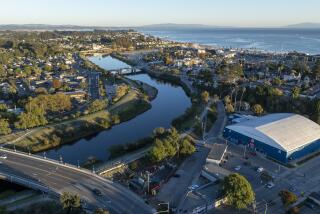PopulationTotal: (1989 est.) 3,5081980-89 change: +3.1%Median Age:...
- Share via
Population
Total: (1989 est.) 3,508
1980-89 change: +3.1%
Median Age: 29.6
Racial/ethnic mix:
White (non-Latino), 57%; Latino, 39%;
Black, less than 1%; Other, 4%
By sex and age:
In hundreds
MALES
Median age:
28.8 years
FEMALES
Median age:
30.7 years
Income
Per capita: $14,034
Median household: $27,955
Average household: $30,685
Income Distribution:
Less than $25,000: 45%; $25,000-49,999: 40%; $50,000-74,999: 12%; $75,000-$99,999: 2%; $100,000 and more: 1%
FOCUS
From Citrus Grove to Civic Center
The landscape of Brea’s Laurel Heights neighborhood was once dominated by lemon and orange groves, grain fields and a few oil rigs. Today it is sporting a new image. Laurel Heights is no longer citrus rich. Rather, the landscape is now dominated by buildings and people wearing business suits.
State College Boulevard and Birch Street are the heart of Brea’s commercial and civic enterprises. The neighborhood’s most conspicuous emblem of change is the Brea Civic & Cultural Center--built 10 years ago on four acres of land donated by the Homart Development Co. The center, with its airy design, was built as a focal point where the community and its businesses would share facilities. It was hoped that the city would prosper from this joint venture.
Some of the facilities that have been designed for the city of Brea’s use and for rental purposes:
Media Center: a 4,000-square-foot area with audio-visual equipment, a fully equipped color television studio, audio rooms, editing systems, photographic darkrooms and a professional staff available to assist users. The “Video Brea Line,” in production since 1986, is taped at this center. The television show has a news magazine and is produced by the city for broadcast over the local government-access cable channel.
Curtis Theatre: capable of seating 199 and hosting full stage productions and concerts; also equipped to handle television tapings, lectures, seminars and meetings.
Training Center: used mostly by schools and the city for teaching purposes, it has a private setting with advanced audio-visual training aids.
Community Room: a versatile, 3,200-square-foot room used for wedding receptions, luncheons, fashion shows, art auctions, fund-raisers and parties.
Council Chambers: a room with stepped semi-circular seating for 105. Equipped with rear projection screen, 7-foot videotape projection, video lighting, sound system and remote-controlled lecterns.
An underground parking area has been built to accommodate the Brea center’s users, as well as people going to the county library and the Police Department administration building.
Scattered throughout the commercial streets are pink, purple and green signs in front of rental buildings. The signs, from Lowe Development, read: “16,000 Square Feet--You Can Have It,” “Top Floor Offices--Room at the Top” and “Small or Large Offices, We’ll Floor You.” The signs bear the name and phone number of Lowe Development, which, even if it can’t prevent miscreants from scribbling on its signs, shows unusual creativity.
According to Susan Georgino, director of redevelopment services for the city of Brea, Laurel Heights and its environs will continue to undergo major changes. Most of the renovation and new construction is by the Lowe Development Co. and by C.P.I. Developers.
In the works is the Embassy Retail Court and Hotel, to be located next door to the Civic & Cultural Center. This will include a 38,000-square-foot retail courtyard, a Robinson’s department store and shops added to the Brea Mall--located directly to the south. Expect to be able to shop there next Christmas.
The Brea Mall itself underwent an $80-million renovation in 1987 and last year rang up gross taxable sales to $188 million--second in Orange County only to South Coast Plaza.
Presently, the out-with-the-old-and-in-with-the-new spirit is claiming the old Brea-Olinda Union High School. Directly in front of the Civic Center, the school was built in 1927. Now, though, it is being demolished to make room for 165,000 square feet of retail shops, a day-care center and more than 40,000 square feet of office space.
In order to broaden cultural awareness in Brea, the “Arts in Public Places” program was formed in 1975. Developers of commercial projects valued at $500,000 or more are obliged to include a sculpture in their designs. So Laurel Heights, with its growth and change, stands an outside chance of also becoming Brea’s own sculpture garden.
More to Read
Sign up for Essential California
The most important California stories and recommendations in your inbox every morning.
You may occasionally receive promotional content from the Los Angeles Times.











